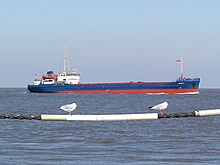Coastal shipping

Under cabotage means the transportation of goods or persons in the coastal area. In the transport of goods mainly be coasters (motor coasters) are used.
German coastal shipping

Coastal shipping in Germany was carried out with a large number of specialized sailing vehicles until the first decades of the 20th century. It mainly concentrated on cabotage , i.e. transport within the country, but also carried out part of the coastal transport between the countries of the North Sea and Baltic Sea region. Until the second half of the 19th century, coastal cargo ships were built almost exclusively from wood . Later, at first at shipyards outside Germany, iron and soon also steel were used, with composite structures made of iron or steel with a floor made of wood for a long time in coastal voyages, especially in the mudflats .
The triumphant advance of the steamships changed the composition of the ships used in coastal travel only slightly, since the capital and personnel-intensive operation of steam engines in this segment of maritime transport did not pay off. The picture only changed with the appearance of the compact and reliable glow-head motor . In the first two decades of the twentieth century, large numbers of coastal sailors with simply constructed and relatively economical diesel engines began to be converted into motor sailers . The engines were initially used as an auxiliary drive, but quickly established themselves as the main drive, increasingly replacing the sails of coastal freighters.
In Germany, coastal shipping is mainly operated with Kümos, such as Rhine-Sea ships , which only have a relatively shallow draft of three to five meters and are therefore able to call at small ports along the coast. The load-bearing capacity of the Kümos is between 650 tons and 6000 tons. Kümos and Rhine-Sea ships up to 3000 tons also use the larger inland waterways. But they have some special design features, such as lowerable wheelhouse and folding masts. Depending on the draft or the water level, they can go as far as the Upper Rhine ports.
The aim of coastal shipping in Germany is to distribute cargoes from small ports on the coast and from larger inland ports, for example on the Rhine, Maas and Waal; further to bring goods destined for overseas to the large seaports, where these goods are then loaded onto (much larger) ocean-going vessels . Kümos and Rhine-See ships travel not only the coasts but also the entire Baltic Sea and English coastal waters. In recent years, the importance of container traffic in coastal shipping has increased enormously. Kümos serve as so-called feeder ships in their function as feeders and distributors of containers .
meaning
Coastal shipping takes place on almost all coasts of the world. The advantage of coastal shipping for the shippers is the possibility of being able to fall back on uninterrupted traffic for shipments to / from inland ports , which may not be reached due to restrictions on larger ocean-going vessels. An additional reloading of the load is therefore not necessary. This not only saves time and money, but also reduces the risk of damage to sensitive loads. The same naturally applies to shipments from the seaports. Here, loading onto coasters can often reach the destination more quickly by sea than using another means of transport.
Since the road mode of transport is reaching its capacity limits in many places, attempts are being made to use the possibilities of transporting goods via coastal shipping more consistently (keyword: “From Road to Sea”).
literature
- Detlefsen, Gert Uwe: From the Ewer to the container ship . The development of the German coasters. Koehlers Verlagsgesellschaft, Herford 1983, ISBN 3-7822-0321-6 .
- Weselmann, A .: Review of the development of coasters from 200 to 1000 GRT . In: Yearbook of the Shipbuilding Society . tape 57 , no. 1963 , 1964, pp. 99-103 .
- Ulrich Schaefer: Gaff schooner in the North and Baltic Seas: German coastal shipping under sails . Ernst Kabel Verlag, Hamburg 1990, ISBN 3-8225-0124-7 .
- Stöcker, Hans Jürgen: Ready for the future - German coastal shipping at the beginning of the 90s . In: Nauticus . tape 39 , 1991, pp. 136-155 .
Web links
- Literature by and about coastal shipping in the catalog of the German National Library
Individual evidence
- ^ Walter Ried: German sailing since 1470 . JF Lehmanns Verlag, Munich 1974, ISBN 3-469-00508-7 , p. 23/24 .
